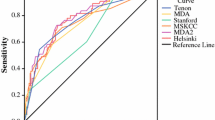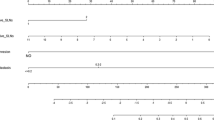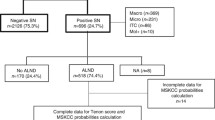Abstract
Background
A Breast Cancer Nomogram (BCN) for predicting nonsentinel lymph node (NSLN) involvement has been developed and prospectively tested in several series. However, its clinical applicability has never been tested among surgeons.
Methods
The BCN was applied to 209 SLN-positive patients. Its performance was assessed by the area under the receiver–operating characteristic (ROC) curve. Surgeons in Quebec were surveyed to determine the predicted NSLN positivity below which they would not dissect the axilla. The accuracy of the BCN was determined in this clinically relevant range.
Results
The predictive accuracy of the BCN had an area under the ROC curve of 0.687. Almost half of interviewed surgeons treat over 20 breast cancer per year. Fourteen out of 82 surgeons questioned would never leave the patient without a completion axillary dissection after a positive SLN, regardless of the BCN result. Seventy one percent of them would not complete axillary dissection if the prediction of a positive NSLN was ≤10%. Only 37 of the 209 patients were in this 10% or less category, with a mean observed rate of positive NSLN of 13% (95% confidence interval [CI], 2–24%).
Conclusion
The global performance of the BCN was fair. A majority of surgeons in Quebec would omit an axillary lymph node dissection (ALND) if the predicted probability of positive NSLN is 10% or less. Although useful, the BCN data should be used with caution at the low end of the scale. Because of some limitations in the performance in this category, other clinical factors and judgment must accompany its use.




Similar content being viewed by others
References
Lyman GH, Giuliano AE, Somerfield MR, et al. American Society of Clinical Oncology, American Society of Clinical Oncology guideline recommendations for sentinel lymph node biopsy in early-stage breast cancer. J Clin Oncol 2005; 23: 7703–20
Cady B, Stone MD, Schuler JG, et al. The new era in breast cancer: invasion, size and nodal involvement dramatically decreasing as a result of mammographic screening. Arch Surg 1996; 131:301–8
Lucci A, McCall LM, Beitsch PD, et al. Surgical complications associated with sentinel lymph node dissection (SLND) plus axillary lymph node dissection compared with SLND alone in the American College of Surgeons Oncology Group Trial Z0011. J Clin Oncol 2007; 25:3657–63
Fisher B, Redmond C, Fisher E. Ten-year results of a randomized clinical trial comparing radical mastectomy and total mastectomy with or without radiation. N Engl J Surg 1985; 312:674–81
Cady B. Case against axillary lymphadenectomy for most patients with infiltrating breast cancer. J Surg Oncol 1997; 66:7–10
Van Zee KJ, Manasseh D-ME, Bevilacqua JL, et al. A nomogram for predicting the likelihood of additional nodal metastases in breast cancer patients with a positive sentinel lymph node biopsy. Ann Surg Oncol 2003; 10:1140–51
Kocsis L, Svébis M, Boross G, et al. Use and limitations of a nomogram predicting the likelihood of non-sentinel node involvement after a positive sentinel node biopsy in breast cancer patients. Am Surg 2004; 70:1019–24
Soni NK, Carmalt HL, Gillett DJ, et al. Evaluation of a breast cancer nomogram for prediction of non-sentinel lymph node positivity. Eur J Surg Oncol 2005; 31:958–64
Smidt ML, Kuster DM, van der Wilt GJ, et al. Can the Memorial Sloan-Kettering Cancer Center nomogram predict the likelihood of nonsentinel lymph node metastasis in breast cancer patients in the Netherlands? Ann Surg Oncol 2005; 12:1066–72
Degnim AC, Griffith KA, Sabel MS, et al. Clinicopathologic features of metastasis in nonsentinel lymph nodes of breast carcinoma patients. Cancer 2003; 98:2307–15
Specht MC, Kattan MW, Gonen M, et al. Predicting nonsentinel node status after positive sentinel lymph biopsy for breast cancer: clinicians versus nomogram. Ann Surg Oncol 2005; 12:654–9
Cripe MH, Beran LC, Liang WC, et al. The likelihood of additional nodal disease following a positive sentinel lymph node biopsy in breast cancer patients: validation of a nomogram. Am J Surg 2006; 192:484–7
Lambert LA, Ayers GD, Hwang RF, et al. Validation of a breast cancer nomogram for predicting nonsentinel lymph node metastasis after a positive sentinel node biopsy. Ann Surg Oncol 2006; 13:310–20
Zgajnar J, Perhavec A, Hocevar M, et al. Low performance of the MSKCC nomogram in preoperatively ultrasonically negative axillary lymph node in breast cancer patients. J Surg Oncol 2007; 96:547–53
Ponzone R, Maggiorotto F, Mariani L, et al. Comparison of two models for the prediction of nonsentinel node metastasis in breast cancer. Am J Surg 2007; 193:686–92
Alran S, De Rycke Y, Fourchotte V, et al. Validation and limitations of use of a breast cancer nomogram predicting the likelihood of non-sentinel node involvement after positive sentinel node biopsy. Ann Surg Oncol 2007; 14:2195–201
Pal A, Provenzano E, Duffy SW, et al. A model for predicting non-sentinel lymph node metastatic disease when the sentinel lymph node is positive. Br J Surg 2007; 95:302–9
Klar M, Jochmann A, Foeldi M, et al. The MSKCC nomogram for prediction the likelihood of non-sentinel node involvement in a German breast cancer population. Breast Cancer Res Treat 2008; Jan 3 (Epub ahead of print)
Fischer JE, Bachman LM, Jaeschke R. A reader’s guide to the interpretation of diagnostic test properties: clinical example of sepsis. Intensive Care Med 2003; 29:1043–51
Benson RB, della Rovere GQ. Axilla Management Consensus Group (2007). Management of the axilla in women with breast cancer. Lancet Oncol 2007; 8:331–48
Orr RK. The impact of prophylactic axillary node dissection on breast cancer survival: a Bayesian meta-analysis. Ann Surg Oncol 1999; 6:109–16
National Surgical Adjuvant Breast and Bowel Project (NSABP) B–32: a randomized Phase III clinical trial to compare sentinel node resection to conventional axillary dissection in clinically node negative breast cancer patients. http://www.nsabp.pitt.edu/ (accessed Feb 2008)
Glimberty V. International Breast Cancer Study Group trial of sentinel node biopsy. J Clin Oncol 2006; 24:210–1
American College of Surgeon Oncology Group (ACOSOG) Z0011. A randomised study of axillary node dissection in women with clinical T1–2, N0, M0 breast cancer who have a positive sentinel node. http://www.acosog.org/synopses/Z0011_Synopsis.pdf/ (accessed June 2008)
Acknowledgments
The authors would like to thank Dr Francine Tremblay, Dr Yves E. Leclerc, and Dr Guy Leblanc for sharing their clinical experience, in addition to that of the authors, to collect data from patients, and Dr Atilla Omeroglu, for help with pathology reviewing.
Author information
Authors and Affiliations
Corresponding author
Rights and permissions
About this article
Cite this article
Poirier, É., Sideris, L., Dubé, P. et al. Analysis of Clinical Applicability of the Breast Cancer Nomogram for Positive Sentinel Lymph Node: The Canadian Experience. Ann Surg Oncol 15, 2562–2567 (2008). https://doi.org/10.1245/s10434-008-0033-9
Received:
Revised:
Accepted:
Published:
Issue Date:
DOI: https://doi.org/10.1245/s10434-008-0033-9




